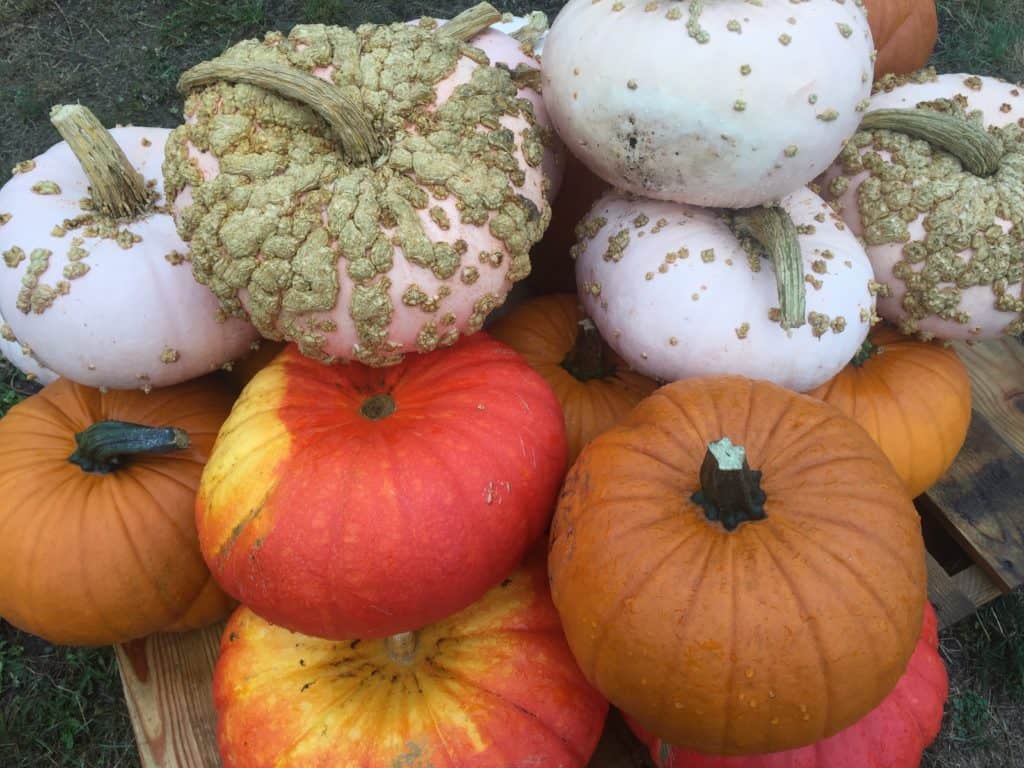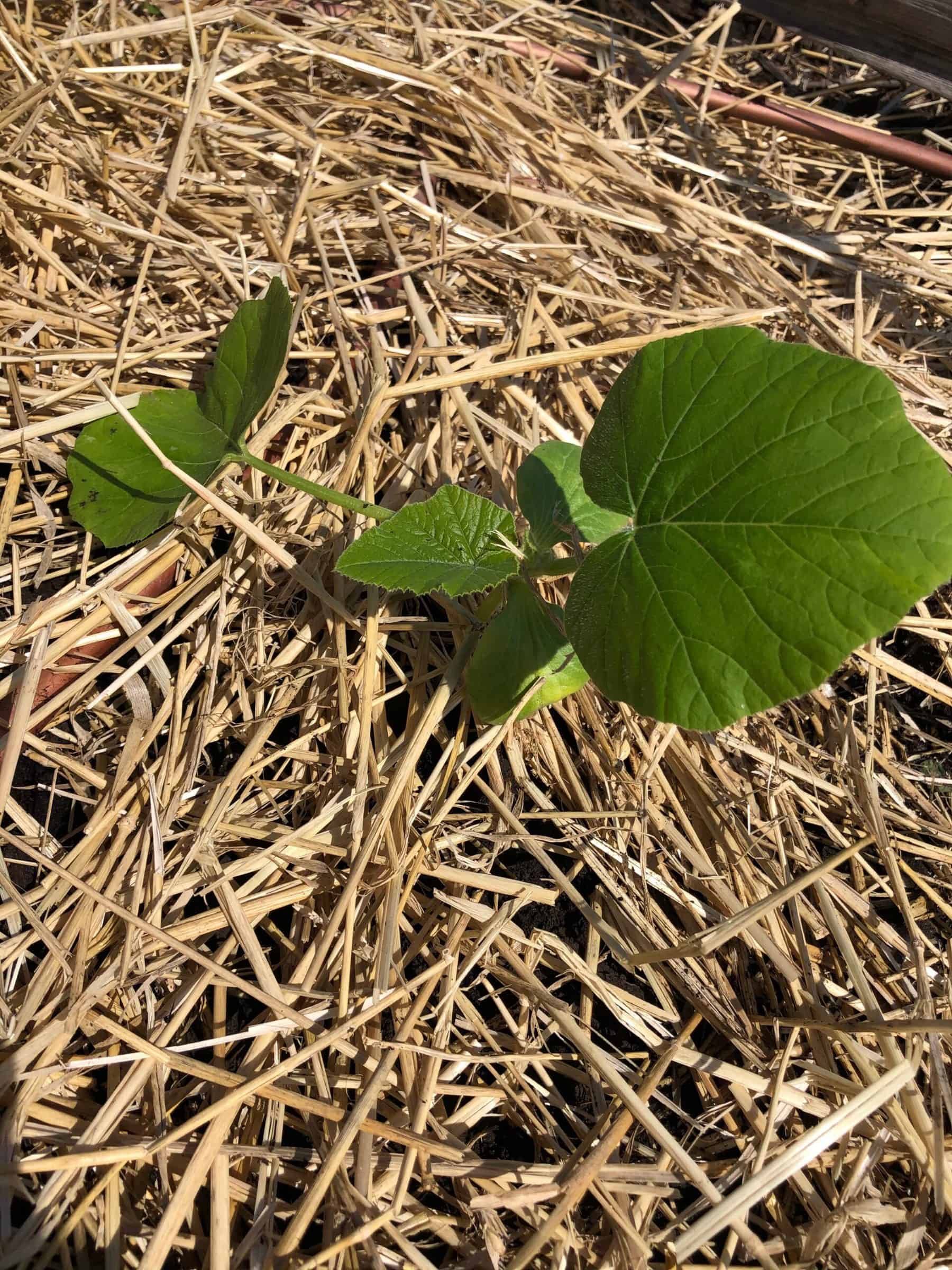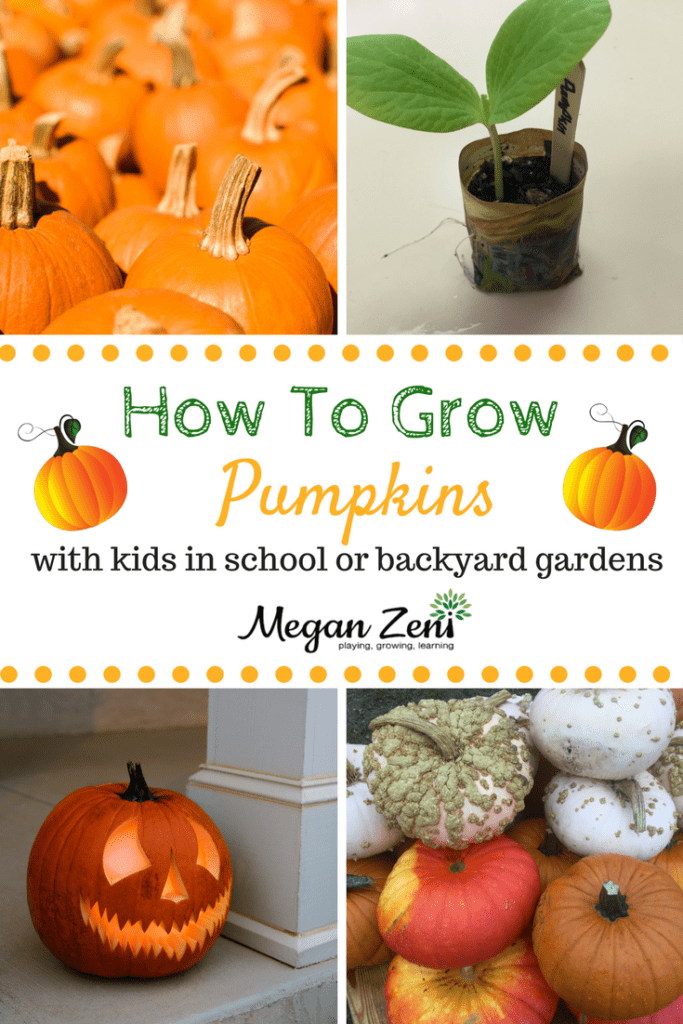- filed under: Recommended Crops, Seasonal Outdoor Learning
How To Grow Pumpkins With Kids
If you are going to have a school garden, then be sure to plan some space to grow your own pumpkins. Pumpkins are easy to grow, have a big impact in your garden and produce one of the most versatile crops to harvest with children. Here’s post on when to plant pumpkin seeds, and how to grow pumpkins with kids in your school or backyard garden at home!
Pumpkin Growth Stages

Pumpkins can be started indoors or sown directly into the garden soil. I like to start our pumpkin seeds indoors because they make for a reliable veggie start that transplants well. Many seed starts indoors can be tricky to harden off and transplant with little fingers, but most squash seedlings are hardy and resilient, so a good choice for seed starting indoors and learning how to transplant. When starting pumpkin plants, you should consider that pumpkins typically grow only 3 or 4 pumpkins on a single vine, less if they’re big pumpkins! So don’t be afraid to overplant those seeds and seedlings! There are so many great books that help learners understand the life cycle of a pumpkin. Read this blog post for a list of my favourites with more suggestions on how to teach using pumpkins.
Pumpkin Seeds
We purchase our seeds from Westcoast seeds. There are many choices of pumpkins that you can plant that will all be available to harvest in October. Consider a mix of large and small pumpkins, smooth and textured, and even colour varieties, like white pumpkins! In my experience, very few thieves know what to do with warty and white pumpkins. Years where we have grown anything but orange pumpkins, have been years with an abundance of squash still in the garden come October.
I also recommend you consider what you want to do with the pumpkins when you harvest them, before you choose your seeds. Some varieties are better suited for carving jack-o-lanterns because of their thinner rinds, and if you go with a Dill’s Atlantic Giant variety, be sure you have a wheelbarrow available to move it when it is fully grown! Gourds and other highly textured squash can be a fantastic sensory experience for children and will save you loads of money if you regularly purchase these decorative squash.
When to Plant Pumpkin Seeds
Pumpkin seeds take four months to grow into a ripe pumpkin. I usually start ours indoors in early May. On the westcoast we want our pumpkin plants started and in the garden by June 15th (at the latest) for a crop that can be harvested before October 31st! When we transplant our seedlings to the garden beds, I over plant the area with extra seeds directly into the soil in case any of the transplants fail. As always, when gardening with kids, over planting is recommended. It is far easier to go back and thin the overgrowth then to try and fill in later in the season with purchased starts.
Pumpkins enjoy a good compost heavy fertilizer. Be sure to prepare the soil for pumpkins by digging in well rotted manure or a liquid kelp fertilizer like “Kelp Man” to get your pumpkins growing quickly!
Caring for Pumpkin Plants
Fertilization can be tricky for pumpkins if the vines are big and bushy. If you have an abundance of pollinator friends in your garden, re-arranging your flowers to make them more accessible is a good idea. The pumpkin will grow from the female flower, which has a distinct bulb shape at the base of the flower. Pumpkins can be hand fertilized as well, which leads to an excellent lesson on pollination, cross pollination, and open pollination.
Pumpkins prefer to be well watered, but do not like having water sprayed on their leaves. Generously water the soil under the vines and add fertilizer weekly for large pumpkins. It can also be helpful to add grass clippings or straw to your garden beds to help regulate the soil temperature, keep the weeds down, and the soil moist. We like to transplant our pumpkin seedlings and then add some straw to the growing area to support the overall health of the plant. Pumpkins are fairly drought tolerant once established, which makes them ideal school gardens crops to grow over the summer when kids are not in session and watering is less frequent.
Pumpkins are susceptible to powdery mildew. This is an airborne fungal disease that looks pretty awful, but generally does not affect the growth of the pumpkins late in the season. Once the mildew has arrived, there is not much you can do. Harvest the pumpkins and dispose of the vines and leaves.
Harvesting Pumpkins
The hardest part about harvesting pumpkins is knowing when to bring them in. In our school garden, we suffer the theft of our pumpkins regularly. The garden is publicly accessed and, like most school gardens, we have to consider the timing of bringing our pumpkins in a bit early to protect them from theft, or leaving them on the vine a bit longer and having someone else harvest them. As general rule, harvesting pumpkins two weekends before Halloween reduces loss and theft.
Simply cut or snap the pumpkins from the vine to harvest. The longer you can leave the stalk, the better. Store the pumpkins in a cool, protected, dry spot for a few days to let them cure before carving or cooking with them.
Teaching with Pumpkins
Pumpkins offer seasonal affordances for learning across the curriculum. In May and June, consider starting pumpkin seeds indoors to transplant out to your garden before June 15. Use calendar math to help your students work out exactly when to plant your pumpkin seeds to ensure they are ready for harvest before Halloween. How long does it take a pumpkin to grow from seed to fruit? Record the phases and stages of pumpkin growth over the growing season, and record how many pumpkins grow on each vine. Graph your results and compare if pumpkins with fewer fruit on the stem grow larger! Consider researching pumpkin companion plants that work in collaboration with pumpkins, and learn more about Indigenous practices, like the three sisters, that increase crop yields and support overall soil health.
Pumpkin STEAM activities
Pumpkins are a popular theme in October classrooms! Here is a related post with some great ideas of how my blogger friends have used pumpkins to inspire learning in Science, Technology, Arts and Maths.
Pumpkin Recipes
Pumpkins are fun to grow and an awesome tool for learning across the curriculum, but they also taste amazing too! If you have an abundance of pumpkins, here is a related post with recipes to try in your classroom or at home with kids!
Learn More!
If you want more Halloween ideas for home or school, be sure to join me on Pinterest:




